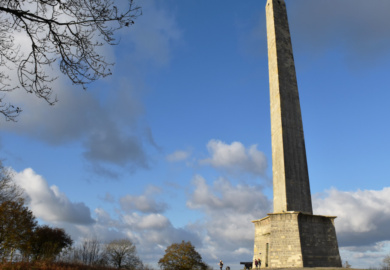We visited St David’s Cathedral in Britain’s smallest city, at the beginning of June.
My sister and her sons live in Haverfordwest, just 16 miles from the city of St Davids and we were visiting her. We had spent the morning in the Pembrokeshire National Park where we had done the walk from Whitesands to St David’s Head. Our nephew had suggested visiting St David’s Cathedral while we were there so after a sandwich at the beach, we headed to the diminutive city.
As you would expect, the city is compact with just four main streets, all of which converge at the war memorial. Along with several listed buildings, there are independent boutiques, cafes, outdoor specialists and art galleries, including the Oriel y Parc Gallery & Visitor Centre which is directly alongside the car park. Here, you will find useful information about the Pembrokeshire Coast National Park, including walking routes, and a pretty gift shop stocked with local handicrafts.
A short stroll takes you along The Pebbles to arrive at St David’s Cathedral, the main reason for our visit.
St David’s Cathedral
Set in a basin meadow, the cathedral is almost hidden from view until you emerge alongside its perimeter wall from where it reveals itself in all its 12th-century, purple-stoned glory.
Entry to St David’s Cathedral is free but they suggest that you may wish to make a donation of £5 per adult. Given that other cathedrals do have entry fees (Wells for example charges £14) and that there is so much to see, a small donation still feels like incredibly good value.
As soon as you step into the nave, you see a magnificent oak ceiling and a beautiful, stained glass, rose window. Other highlights include the Quire with its carved seats and medieval floor tiles; the pretty cloisters; and St David’s Shrine to which hundreds of thousands of faithful make a pilgrimage. The pilgrimage was deemed so important in the currency of faith that Pope Calixtus II declared two pilgrimages to it equal to one to Rome, and three equated to one to Jerusalem.
Bishop’s Palace
Sitting alongside the cathedral, on the far bank of the River Alun, lie the impressive ruins of the Gothic Bishop’s Palace, like the brooding set of a Dracula movie.
As thousands of pilgrims flocked to St David’s Shrine in the early 14th-century, Henry de Gower turned the existing, humble Bishop’s residence into a palace. Keeping the east wing as his private home, Bishop Gower used the south range in which to wine and dine distinguished guests and pilgrims, and from which to dispense justice. But the Reformation, and the first Protestant Bishop of Wales, saw the lead stripped from the roof and inevitable slow decline set in.
You can go inside the Palace (times & prices below) which gives you access to an exhibition and gift shop as well as the use of picnic tables, but we didn’t have time and were quite happy just to view it from outside.
Visitor information:
St David’s Cathedral; open Mon-Sat 1000-1600, Sun 1300-1500; entrance free but donation of £5 welcome.
Bishop’s Palace; open every day except 24,25, 26 December & 1 January 0930-1600 (Nov-Feb), 0930-1800 (July& August), 0930-1700 (March-June, Sept & Oct); entrance £6.80





